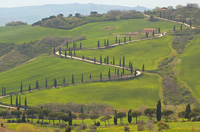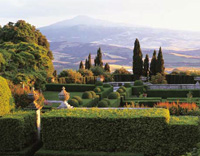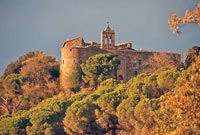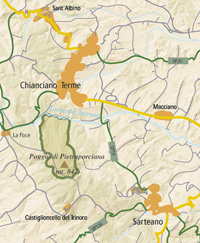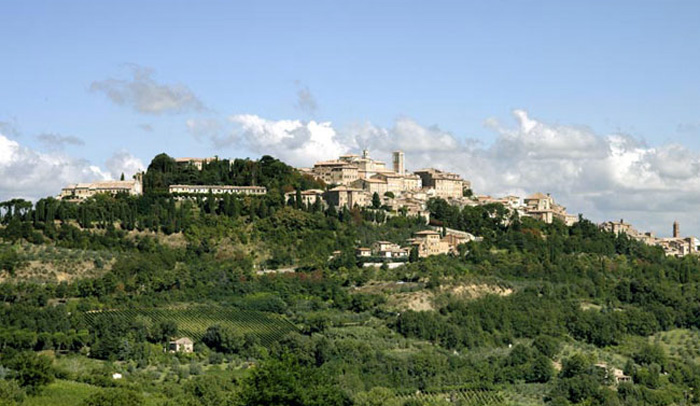 |
|
| N L | Chianciano Terme |
|
| Chianciano Terme stands on a hilltop overlooking to the west the Chiana valley, between Chiusi and Montepulciano. Chianciano Vecchia, as is called the ancient town of Chianciano, is very different from the modern quarter that has grown all around the Terme. It is situated on a hill and shows part of its medieval town walls and its medieval urban plan. The gate of the town is at the end of Via Dante, where stands Porta Rivellini with its elegant Renaissance structure. Chianciano is one of the most important Italian spa centres. Its spas are famous from Etruscan time. Today, Chianciano Terme is considered among the finest health resorts in Europe.The Church of the Immacolata, restored in 1588 after the Florentine conquest of Siena. It once housed the paintings of Annunciation by Niccolò Betti, a Holy Family by Galgano Perpignani and a fresco of Madonna of the Peace attributed to Luca Signorelli, currently all in the museum of the Collegiata Church of San Giovanni Battista. This is a Romanesque-Gothic building with a notable portal. It houses a Holy Scene fresco (16th century), a 14th century crucifix and a wooden Dead Christ by Giuseppe Paleari (1783). The church of Madonna della Rosa takes its name ("Madonna of the Rose") by a fresco portraying the Virgin giving a Rose to the Child, work of a 15th century Sienese master. Also from a Sienese artist is the Madonna delle Carceri (14th century). The Etruscan Archeological Museum of Chianciano Terme
|
| |
Between the medieval towns of Pienza, Chianciano and Montichiello, lies Villa La Foce and the equally idyllic located Castelluccio. Villa La Foce, a Tuscan villa created by the writer Iris Origo and her husband Antonio Origo.Villa La Foce is located in the crete senesi overlooking the Val d'Orcia. After having bought La Foce in 1924, Antonio and Iria Origo commissioned the English architect Cecil Pinsent, who had previously designed the gardens at Villa Medici in Fiesole, to restructure the main buildings and to create a large formal garden. The medieval castle of Castelluccio (literally little castle) lies on the summit of a hill on the La Foce estate. |
||
|
|
||
| Pinsent designed the structure of simple, elegant, box-edged beds and green enclosures that give shape to the Origos' shrubs, perennials and vines, and created a garden of soaring cypress walks, native cyclamen, lawns and wildflower meadows. Today the estate is run by the Origo daughters, Benedetta and Donata, and is open to the public every Wednesday afternoon. [read more] Each summer, the cultural association La Tartaruga organizes art shows at the medieval castle Castelluccio, which is part of the estate. The curator, Plinio de Martiis (known for his important gallery in Rome) has in recent years brought the work of renowned artists such as Kounellis and Manzoni to Castelluccio, as well as promoting young, less famous artists. The chamber music festival Incontri in Terra di Siena, was founded in 1989 by Benedetta Origo and her son, Antonio Lysy, in memory of Iris and Antonio Origo. The festival is held each year at the end of July / beginning of August. Villa La Foce is located in the Val d'Orcia on the other side of Monte Amiata, and less than an hours drive from Podere Santa Pia. Villa La Foce Estate | La Foce - 61, Strada della Vittoria -53042 Chianciano Terme - Siena | www.lafoce.com At the top of the ridge is the main entrance to the villa, still owned by the Origo family and since 1998 the seat of a foundation for the study of the landscape and environment of the Val d'Orcia. The gardens may be visited on Wednesdays (15.00-dusk; entrance fee, which is donated to charity). Ask at the farm office in the courtyard to the left of the house. They are usually at their best in May, June and September. Gardens in Tuscany | Villa La Foce |
|
|
| Villa Simoneschi, an ancient private villa dating back to around 1830, is situated in the immediate vicinity of the historical centre of Chianciano Terme. The three-storey building, entered through a monumental gateway on Via Dante, stands at the centre of a fine garden filled with flowers: most notably rose bushes, but also some quite rare plants. From the entrance, a Neoclassical chapel is seen to the right, with a huge Lebanon cedar towering beside it like some monumental belltower; on the opposite side is a stone fountain with spring water. A few steps lead down to the shadier, more private part of the park: a formal garden with tall trees. The forecourt to the south of the villa is dominated by a fine fountain, at the centre of a pool with an elegant lobe-shaped surround in an area paved with local stone, and with four unusually designed benches, also in stone, around the perimeter. At the end of the forecourt, towards Monte Cetona and the valley below, is an impressive panoramic terrace. |
||
| La Chiesa della Madonna della Rosa |
||
| Just at few metres from Porta del Sole, stands the temple dedicated to Madonna of Rose, the most beautiful church in Chianciano, designed in 1569 by Baldassarre Lanci, the architect of the Duke of Urbino. Inside the Chiesa della Madonna della Rosa, you can admire a wall painting representing Madonna of Rose, who was considered as the patron saint of Orvieto with at her sides St. John and St. Bartholomew, the patron saints of Chianciano. The pillar at the entrance represents a particular scene of rural life, witness to local farmers' financial support to the building of the church. |
 |
|
Walking and trekking in Tuscany | Walking in the Val d'Orcia |
||
| Riserva Naturale di Pietraporciana |
||
| The Pietraporciana Nature Reservecovers the top, the northern side, and part of the southern side of the homonymous hillock (847 m), belonging to the ridge that, between Chianciano Terme and Sarteano, separates Val d’Orcia from Val di Chiana In the beech tree wood of Pietraporciana | Departure in Sarteano (the road to Castiglioncello), arrival in Sarteano. In the Rocconi forest, which lies between the magical world of the Crete of the Val d’Orcia and the neatly organized farm land of the Val di Chiana, there is a stand of secular beech trees which is documented and marked by the Italian Botanical Society. This antique place protects beneath its rock walls, giant beech trees as well as other rare plants, flowers of every kind and lush moss that covers enormous boulders. Castiglione d'Orcia - Castiglione d'Orcia The itinerary starts on a downslope and ends uphill. From the hamlet of Castiglione d'Orcia we get to the bottom of the Orcia valley which is characterized by a wild environment where no means of transport are possible. It predominantly unfolds on dirt tracks. For the mountain bike enthusiasts it doesn't show any technical difficulties even though the downslope, specially in the first part, is very steep and the climbing back up is quite challenging. Vivo d'Orcia - Vivo d'Orcia From Vivo d'Orcia we start downhill toward the white-fir forest of Vivo d'Orcia, one of the last remaining in Tuscany of this kind. Follow the indication Contea del Vivo/Eremo and take the Via Amiata becomes Via dell'Eremo. At the end of the road we cross the bridge over the Vivo stream passing under a stone arch that leads to the Borgo dell'Eremo. Castelnuovo dell'Abate - Vivo d'Orcia This spectacular itinerary descends from the Abbazia di Sant'Antimo, surrounded by silence and Brunello vineyards, then climbs up the pristine slopes of Monte Amiata, an ancient extinct volcano. The trip ends up in Vivo d'Orcia, one of the most well-conserved and verdant localities in Tuscany, charged with energy from the volcano.
|
|
|
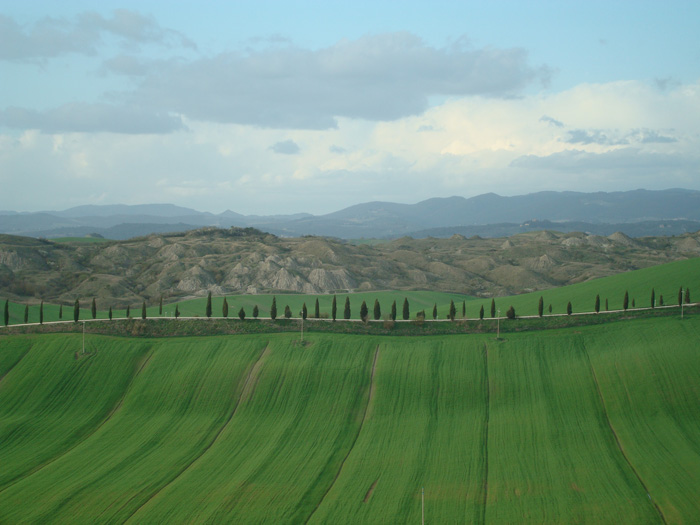 |
| The Crete Senesi abound in Medieval hamlets, churches, castles and fortresses, as well as many farms that indicate the strong peasant traditions of this area. Podere Santa Pia is an enchanting property, situated in a fantastic panoramic position amidst the green and picturesque Tuscany countryside, close to the most famous cities of art and near the Brunello area, famous for its vineyards and the most prestigious wines. |
Chianciano Terme borders the following municipalities: Chiusi, Montepulciano, Pienza, Sarteano. |
|
|
Extract from the Guide to Chianciano Terme and its outskirts by Mrs. S. Orienti and G. Vagaggini Poppi |
Chianciano Vecchia or Paese, as is called the ancient town of Chianciano. Its aspect is very different from the modern quarter that has grown all around the Terme. It is situated on a hill and shows part of its medieval town walls and its ancient urban plan. The gate of the town is at the end of Via Dante, where stands Porta Rivellini with its elegant Renaissance structure.
|
One of the best places for slow traveling in southern Tuscany is Podere Santa Pia. Located on the outskirts of Castiglioncello Bandini, in a hilly and unspoilt land, Podere Santa Pia is an artistic property, perfect for relaxing and enjoying the splendor of the Maremma hills of southern Tuscany. Holiday accomodation in southern Tuscany | Podere Santa Pia |

